Tadpole 101 and Identification

Do Tadpoles Really Have Teeth?
It's Spring, and despite the weather doing its bipolar dance of 40's to 70's and back, the animals and plants are already starting to bloom, call, sing, mate, and lay eggs. Here where I live spring peepers are vociferously calling every night. Soon they will be joined by cricket frogs, bull frogs, leopard frogs, green frogs, grey tree frogs, pickerel frogs, wood frogs, and toads. Already there are quite a few tadpoles of mixed origin gracing our vernal pools and ponds, which leads me to today's post about tadpoles. Tadpoles are the larval stage of amphibians. Most people only think about tadpoles as being frogs, but don't leave out their moist cousins (which have larval tadpole stags too) such as salamanders and toads. With that said, let's dive into the world of tadpoles.
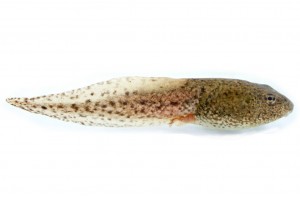
Etymology of Tadpole and Pollywog
The word tadpole comes from the English of "tad" or "toad" and "pol" or "head." They are literally toad heads. For those that use the term pollywog, again "pol" is "head" and "wog" is "to wiggle." Pollywog means wiggle-head. Both are quite descriptive.
Start with Knowing What Frogs and Toads Live Near You
Before you get too far into learning about tadpoles you really should know what frogs are in your area. If you can, pick up a good local field guide, such as the Peterson's field guides or the "Reptiles and Amphibians of Delmarva." You could also read my previous blog post on "Resources to Help you Learn Frog Calls."
Why Do Tadpoles Live in Water?
The Greek term "amphibios" means living on land and water, and is the root word of our 'amphibian.' Essentially, they have double lives. Amphibians are exotherms (some say cold blooded) and they rely on nature to regulate their temperature. They can't keep their bodies warm by themselves, and part of this regulation process is having wet skin. Wet skin allows for oxygen exchange and keeps amphibians moist and cool. This is in part why they live around water and in damp or wet places. Amphibians also lay eggs in water. This is because their eggs don't have the same leathery or hard covering of their cousins, the reptiles and birds. Amphibian eggs are gelatinous and need to be in water to keep from dehydrating and dying.
How to Tell Salamander Egg Masses from Frog Egg Masses
One way to identify amphibians, if you can't see mom and dad, is to examine their egg masses. Typically salamander egg masses have a gelatinous covering or packet around them, while frog egg masses have individual eggs but no slimy cocoon of goodness like salamander eggs have.

Typically salamander eggs are rounder and firmer than those of frogs, and often the cluster will take on a whitish hue as they mature.
Amphibians usually lay eggs in one of four formations; strings (toads), small thin clusters attached to plants or twigs, larger chunky clusters, or small rafts that float in the water. If you live in Mid-Atlantic states or the Eastern US, you can find some great guides to help you with frog Egg and larval id. One resource I like is the MId Atlantic Nature Blog, which has good photos of egg masses. Another great starting place is the USGS Field Guide to Amphibian Larvae and Eggs of Minnesota, Concision, and Iowa. They have some great information on starting your ID, and a nice "wheel of ID" for eggs and larvae. Here's a frog egg diagram from the field guide that I find helpful:

Tadpoles ID Starts With Anatomy
The time it takes for amphibian eggs to hatch varies by species, weather, and water temperature. Eggs can hatch in a few days or a few weeks. Amphibians that lay eggs in vernal (temporary) pools of water (such as wood frogs) usually have eggs that hatch faster than those that lay in more permanent ponds and pools. Regardless, all good tadpole ID starts with capturing the wee beasties and observing them. You'll need a good dip-net, a clear container (plastic is often safer, but glass is easier to see through), a ruler and wet hands for handling them. Always remember to wet your hands, and keep a steady supply of cool fresh water on hand so that your tadpoles (they are babies after all) don't get stressed.

There are several basic features you need to know when you're identifying your wiggle-heads or tadpoles. Here I'm focusing mostly on frogs, not salamanders, and due to time, just the anatomy of the larval-limbless frogs:
TADPOLE ID FEATURES TO LOOK FOR
- Size (snout to tail)
- General body shape
- Head size and shape
- Eye placement (top or sides)
- Spiracle (breathing tube) placement
- Size of dorsal (top) fin
- Size of ventral (bottom) fin
- Size and coloration of tail musculature (middle muscle in the tail)
- Oral disc shape and size (this is their mouth hole under their head)
- Tooth shape and size (yes you have to look at its kisser)
- Poop shoot placement (also called the vent)
- Limb bud placement (where their little legs grow out of)
The USGS has a wonderful free PDF on identifying tadpoles of the Southeastern US and Coastal Plains by Denise R. Gregoire (click here to download it). Another is the USGS Patuxent Wildlife Preserve online key, which is free. It's called, "Tadpoles of the United States and Canada: A Tutorial and Key." Below area couple of diagrams from the online guide to get you started, first with general tadpole anatomy and then tadpole tail morphology and coloration.
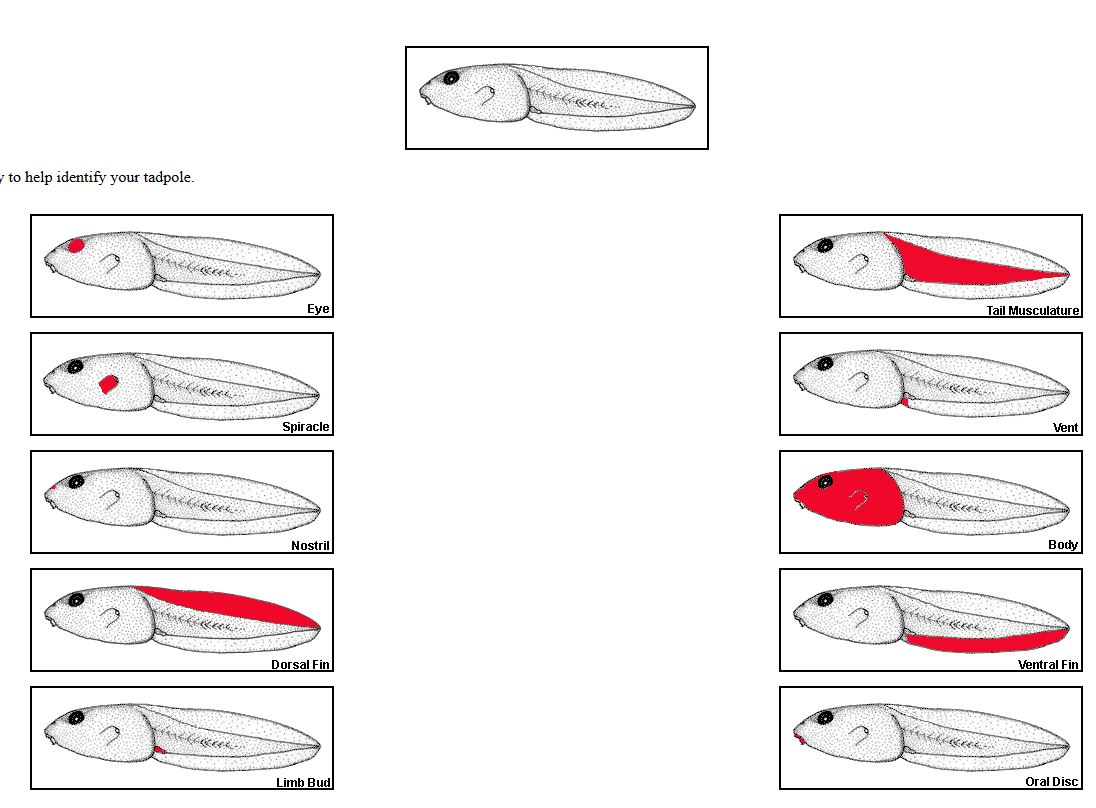
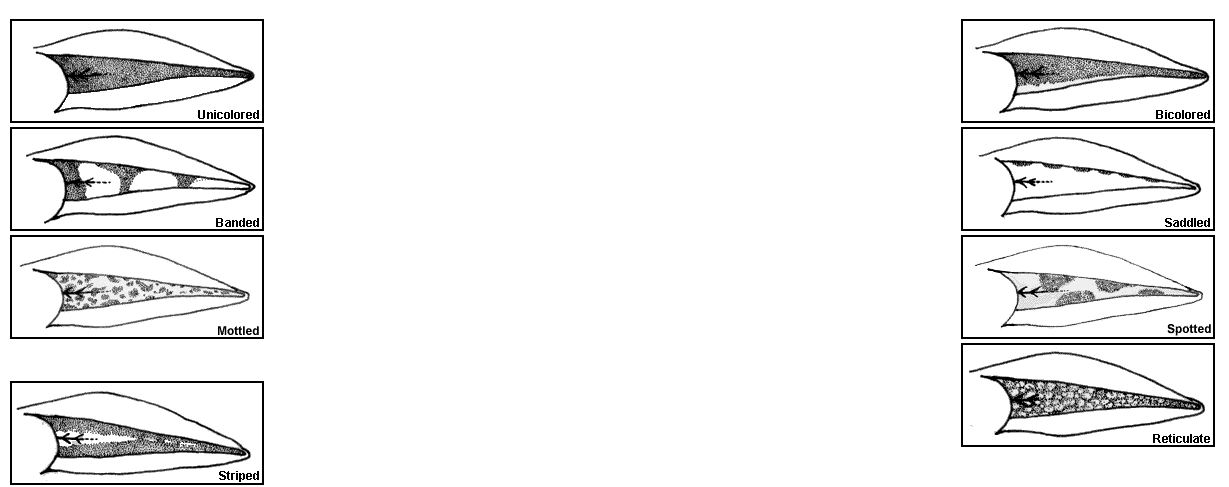
The Gregoire guide (PDF) also has a nice diagram of common tadpoles side by side, which is handy. Keep in mind though, there can be quite a range of color variation, and these are only "archetypes" not absolute-final images of a species.
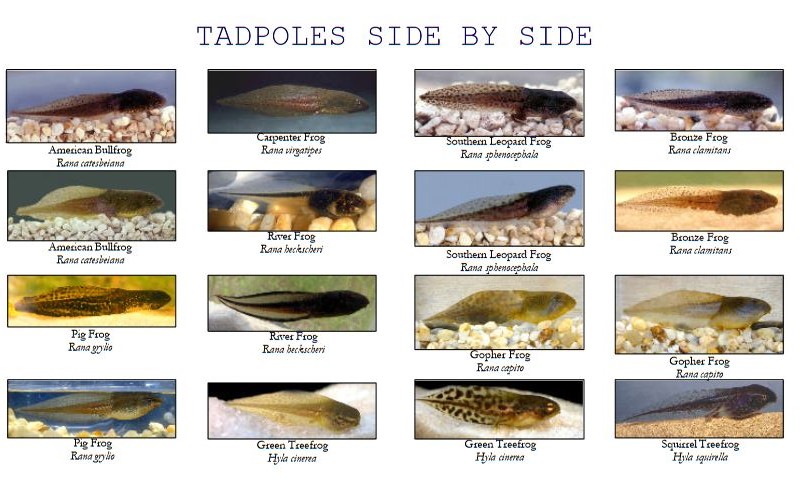
Tadpole Teeth?
Tadpoles have teeth? Run!!!!! No, really, tadpoles do have teeth, but it's nothing to worry about. Remember how earlier I mentioned that amphibians have a "double life"? Well, they do, and it consists of living in ponds and eating mostly vegetation, then goes to growing legs (a few eat aquatic bugs), hopping onto land and becoming a carnivore, eating terrestrial bugs, worms, etc. Even though tadpoles are vegetarians, they have very useful tooth patterns that can help you identify them. The secret to this is that you really should have a good dissecting microscope to see them.
A tadpole's mouth is called its oral disc. The oral disc can have a wide range of shapes and sizes, from what looks like a sippy straw (narrow mouth frogs) to lips from Mick Jagger. Tadpole mouths have jaw sheaths (coverings) whose unique shapes look almost like lips and can be used to start sorting them. Jaw sheaths are keratinized (like fingernails) and can be pigmented. Below is a picture from the USGS Patuxent guide.

The oral disc of a tadpole surrounds the jaw sheath, and includes the labial teeth. The labial teeth are nothing more than scrapers made out of keratin (almost like rows of serrated windshield scrapers). They are used to scrape algae and plankton for the tadpole to suck up. There's a whole formula for calculating how many labial teeth a tadpole has, it's called the tadpole labial tooth formula (yes, scientists are nerdy and classify everything). You can find it on this page from the USGS: https://www.pwrc.usgs.gov/tadpole/tadtrow.htm. Essentially you're counting how many rows of scrapers there are above or below the jaw sheath, and if there are fringes around the oral plate (yes, tadpoles can have fringy mouths, such hippies!). Here's a diagram to give you an idea of what they're looking for:
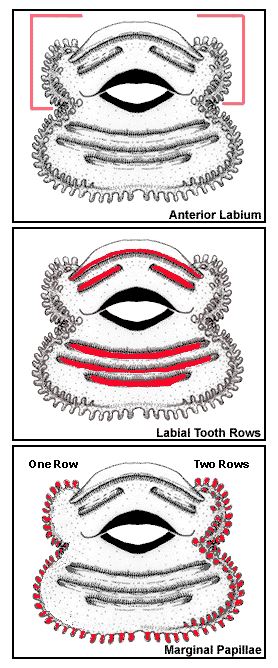
I doubt most individuals will ever get to looking at tadpole oral discs or labial tooth rows too closely, but they're really fascinating. For the most part you'll be better off using color, size, location, and a good field guide (like the ones listed earlier) to help you in your identification.
Remember, always respect our tadpole friends and handle them carefully with wet hands, and always return them to the ponds they came from. Happy tadpole hunting!

